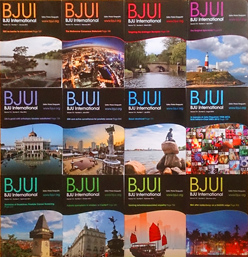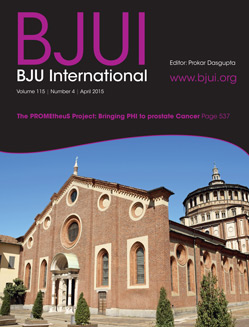
Editorial: Cardiopulmonary exercise testing: fortune-teller or guardian angel?
In this month's issue of BJUI, Tolchard et al. [1] describe their experience with the use of cardiopulmonary exercise testing (CPET) in patients undergoing radical cystectomy. In particular, they assess the value of cardiopulmonary reserve in predicting complications and the length of stay in hospital after surgery.
The origin of CPET is in non-surgical specialties for the further investigation of patients with cardiac failure or unexplained breathlessness [2], but it subsequently…

Editorial: A 3D window into the body?
If real-time tracking is accurate enough to tell you that Roger Federer's serve was on the line or that David Beckham's free kick was indeed over the goal line, then surely tracking systems could help us guide needles and wires into different parts of the body? In this month's BJUI, Marien et al. give us an insight into the future of access for percutaneous procedures [1]. Currently, percutaneous access to the body for biopsy, renal access or treatment of malignancy is usually based on two-dimensional…

Urologists in the Yellow Submarine – a Periscope to the World
5 Comments
/
Over the last few weeks, there has been a lot of chatter about a new Social Media platform. Just when you thought that we had exhausted all possible ways that people could interact online, live video streaming is the talk of the town.
Last month, two competing live video streaming apps were launched. Meerkat initially gained popularity quite rapidly, particularly through Twitter, given the ease and immediacy of being able to share your live video streaming with twitter followers. Twitter acquired…

William Steers 1955-2015
By Montesbradley (Own work) [CC BY-SA 3.0 (https://creativecommons.org/licenses/by-sa/3.0)], via Wikimedia Commons
Last June, we had the great pleasure of hosting Dr. William Steers, Editor-in-Chief of the Journal of Urology as our guest speaker during the BJUI session at BAUS. He delivered a Prezi presentation entitled "Being Wrong" - an amazing collage of his experiences as a surgeon, innovator, scientist and editor. The lecture struck a chord with many colleagues both senior and junior, purely…

Editorial: A urologists’ guide to the multi-parametric magnetic resonance imaging (mpMRI)-galaxy
The rise of multi-parametric MRI (mpMRI) for the assessment of patients with suspicion of prostate cancer has led to an enormous shift in the practice of every urologist dealing with frontline diagnostics [1].
At the same time, researchers and industry have identified acres of fruitful soil to place the seeds of their respective interests, sometimes in collaboration with each other producing valuable contributions to this shift in practice, sometimes taking benefits by merely assimilating…

Editorial: The need for standardised reporting of complications
In the context of diversifying practice models, implementation of new technologies such as the Da Vinci surgical robot and rising healthcare costs, there is growing interest in evaluating the quality of surgical work. This extends into health policy, as reimbursement penalties are introduced for ‘inappropriate’ outcomes (e.g. excessive readmissions). Consequently, there is a significant need to provide an accurate assessment of complications and mortality when reporting on surgical outcomes.
Despite…

Editorial: Time to replace PSA with the PHI?
Yet more evidence that the PHI consistently outperforms PSA across diverse populations
The Prostate Health Index (PHI) has regulatory approval in >50 countries worldwide and is now being incorporated into prostate cancer guidelines; for example, the 2014 National Comprehensive Cancer Network Guidelines for early prostate cancer detection discuss the PHI as a means to improve specificity, using a threshold score of 35 [1]. The PHI is also discussed in the Melbourne Consensus Statement [2], and…

Future Directions in Urological Oncology
The field of urological oncology is rapidly changing. For example, robotic surgery, targeted therapy, and ablation techniques are oncological options that were in their infancy 10 years ago and are now mainstream in many areas of the world. Additionally, immunotherapy has recently become a promising avenue in multiple urological cancers. As we move forward, expect to see a larger presence of urological oncology literature obtained via social media, which BJUI has initiated and subsequently set…

EAU 2015 Review Days 3 and 4
Persistent rain throughout this year’s 30th EAU Annual Congress failed to dampen the spirits of over 12,000 delegates who have enjoyed another fantastic congress here in Madrid. The EAU Scientific Committee, led by Arnulf Stenzl, deserve tremendous credit for the work they have done to construct an extremely comprehensive and stimulating programme once again this year. I do recall my last EAU Congress in Madrid 12 years ago and there is no doubt but that the standard of this meeting has risen exponentially…

Editorial: How much potential for Transient Receptor Potential channels in the bladder?
In this issue of the BJUI, Charrua et al. [1] report on the possible interaction of two members of the vanilloid subfamily of transient receptor potential (TRP) channels in the control of rat urinary bladder function, TRPV1 and TRPV4. TRP channels are a family of cation-selective channels with 28 known mammalian members. Six of them belong to the subfamily of vanilloid receptors (TRPV channels) and fall into four groups, TRPV1/TRPV2, TRPV3, TRPV4, and TRPV5/TRPV6. The physiological and pharmacological…
